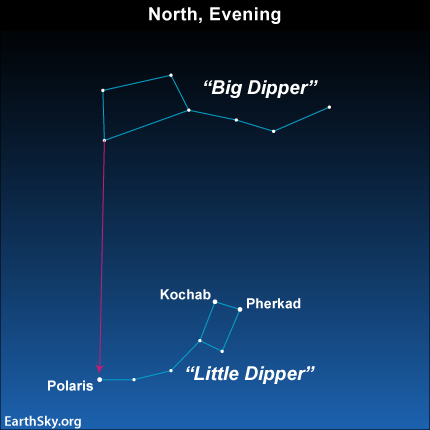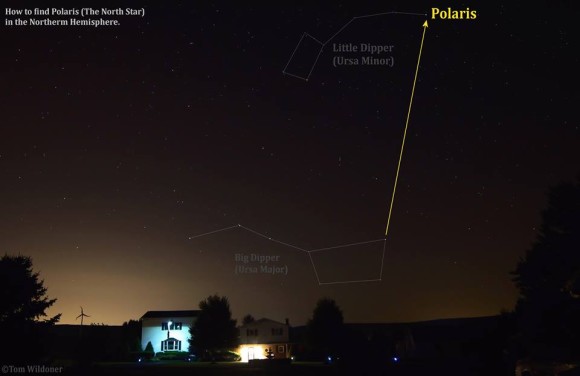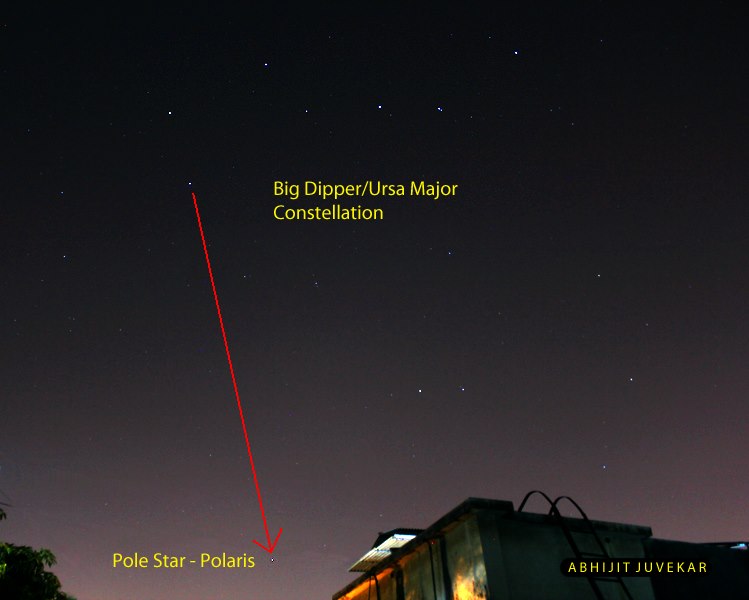
You can find the Big Dipper, but not the Little Dipper? This post is for you. The chart above shows the view northward on April evenings. At present the Big Dipper is high in the north during the evening hours. Notice the two outer stars in the bowl of the Big Dipper. These two stars – called Dubhe and Merak – always point to Polaris, the North Star.
And, once you’ve found Polaris, you can find the Little Dipper.
So go outside in the evening, and face north. Assuming you can see a scattering of stars from your location, you should be able to spot the Big Dipper high in the north in the evening hours. Notice it has two parts: a handle and a bowl. Duhbe and Merak – sometimes called “the pointers” – will be pointing to Polaris. Polaris is part of the famous – though elusive – star pattern, known as the Little Dipper.
The North Star, Polaris, marks the end of the Little Dipper’s handle. If your sky is dark enough, you will be able to pick out the Little Dipper pattern of which Polaris is a part. Still can’t see the Little Dipper? Generally speaking, its stars aren’t as bright as those in the Big Dipper. Try looking in a darker sky.

Kochab and Pherkad are the 2 outermost stars in the bowl of the Little Dipper. They used to be pole stars!
Polaris is also special because Earth’s northern axis nearly points (nearly) to its location in the sky. It’s the star around which the entire northern sky appears to turn.
Polaris is less than a degree away from the true north celestial pole on the sky’s dome now. It’ll be closest to true north – less than half a degree away – in the year 2102. The change in the location of the celestial pole with respect to Polaris is due to a motion of Earth called precession. This motion causes Earth’s axis to trace out a circle among the stars every 26,000 years.
Polaris wasn’t always the North Star. Thousands of years ago, it was an ordinary star in the northern sky, known to the Greeks by the name Phoenice. Slowly, over eons of time, the north celestial pole moved closer to Polaris.
Other ordinary stars in the northern sky now have also had the honor of being pole star, aka north stars. That includes Kochab and Pherkad, the two outermost stars in the bowl of the Little Dipper (see chart above) –
Kochab and Pherkad served as twin pole stars from about 1500 B.C. to about 500 B.C.
They’re still sometimes called the Guardians of the Pole.
Kochab is located about 126 light-years away. Pherkad is more distant, at about 480 light-years by some estimates. Meanwhile, Polaris is a bit more than 400 light-years away.

View larger. | It doesn’t matter how the Big Dipper is oriented in your sky. If you can see it, the 2 outer stars in its bowl will point to Polaris. In this shot, Tom Wildoner caught the Big Dipper and Polaris at around 3:30 a.m. in July 2013. Thanks, Tom!

View larger. |Here’s a differently oriented Dipper, with its 2 outer stars still pointing to Polaris, the North Star. Photo by EarthSky Facebook friend Abhijit Juvekar Thank you, Abhijit!
Bottom line: The Big Dipper is usually pretty easy to find, but the Little Dipper is less easy. This post tells you how to use the Big Dipper to find Polaris and the Little Dipper, plus how to recognize the stars Kochab and Pherkad.
EarthSky astronomy kits are perfect for beginners. Order today from the EarthSky store
Donate: Your support means the world to us
from EarthSky https://ift.tt/2CO2dJh

You can find the Big Dipper, but not the Little Dipper? This post is for you. The chart above shows the view northward on April evenings. At present the Big Dipper is high in the north during the evening hours. Notice the two outer stars in the bowl of the Big Dipper. These two stars – called Dubhe and Merak – always point to Polaris, the North Star.
And, once you’ve found Polaris, you can find the Little Dipper.
So go outside in the evening, and face north. Assuming you can see a scattering of stars from your location, you should be able to spot the Big Dipper high in the north in the evening hours. Notice it has two parts: a handle and a bowl. Duhbe and Merak – sometimes called “the pointers” – will be pointing to Polaris. Polaris is part of the famous – though elusive – star pattern, known as the Little Dipper.
The North Star, Polaris, marks the end of the Little Dipper’s handle. If your sky is dark enough, you will be able to pick out the Little Dipper pattern of which Polaris is a part. Still can’t see the Little Dipper? Generally speaking, its stars aren’t as bright as those in the Big Dipper. Try looking in a darker sky.

Kochab and Pherkad are the 2 outermost stars in the bowl of the Little Dipper. They used to be pole stars!
Polaris is also special because Earth’s northern axis nearly points (nearly) to its location in the sky. It’s the star around which the entire northern sky appears to turn.
Polaris is less than a degree away from the true north celestial pole on the sky’s dome now. It’ll be closest to true north – less than half a degree away – in the year 2102. The change in the location of the celestial pole with respect to Polaris is due to a motion of Earth called precession. This motion causes Earth’s axis to trace out a circle among the stars every 26,000 years.
Polaris wasn’t always the North Star. Thousands of years ago, it was an ordinary star in the northern sky, known to the Greeks by the name Phoenice. Slowly, over eons of time, the north celestial pole moved closer to Polaris.
Other ordinary stars in the northern sky now have also had the honor of being pole star, aka north stars. That includes Kochab and Pherkad, the two outermost stars in the bowl of the Little Dipper (see chart above) –
Kochab and Pherkad served as twin pole stars from about 1500 B.C. to about 500 B.C.
They’re still sometimes called the Guardians of the Pole.
Kochab is located about 126 light-years away. Pherkad is more distant, at about 480 light-years by some estimates. Meanwhile, Polaris is a bit more than 400 light-years away.

View larger. | It doesn’t matter how the Big Dipper is oriented in your sky. If you can see it, the 2 outer stars in its bowl will point to Polaris. In this shot, Tom Wildoner caught the Big Dipper and Polaris at around 3:30 a.m. in July 2013. Thanks, Tom!

View larger. |Here’s a differently oriented Dipper, with its 2 outer stars still pointing to Polaris, the North Star. Photo by EarthSky Facebook friend Abhijit Juvekar Thank you, Abhijit!
Bottom line: The Big Dipper is usually pretty easy to find, but the Little Dipper is less easy. This post tells you how to use the Big Dipper to find Polaris and the Little Dipper, plus how to recognize the stars Kochab and Pherkad.
EarthSky astronomy kits are perfect for beginners. Order today from the EarthSky store
Donate: Your support means the world to us
from EarthSky https://ift.tt/2CO2dJh

Aucun commentaire:
Enregistrer un commentaire